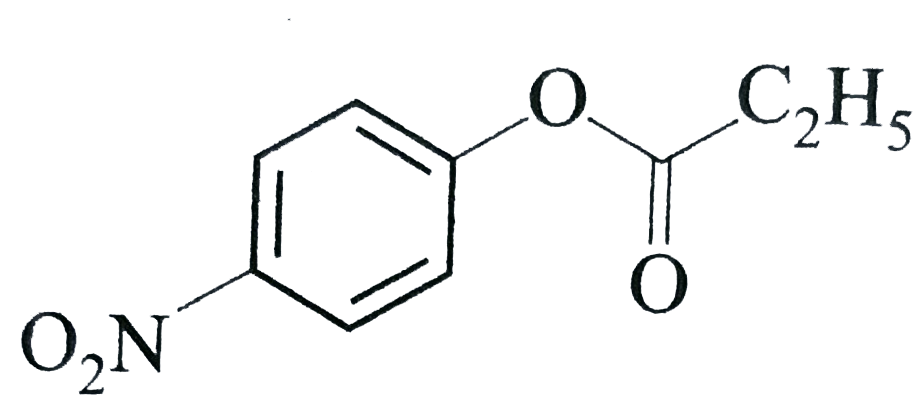The ester among the following is
Calcium lactate
Ammonium acetate
Sodium acetate
None of these
The correct Answer is:D
To determine which of the given compounds is an ester, we need to analyze the options provided.
1. Identify the Compounds: The question provides three compounds: calcium lactate, ammonium acetate, and sodium acetate. We need to analyze each to see if any of them is an ester.
2. Understanding Lactic Acid:
- Lactic acid has the formula CH₃CHOHCOOH.
- Calcium lactate is formed when lactic acid reacts with calcium ions. The formula for calcium lactate can be represented as (CH₃CHOHCOO)₂Ca.
3. Understanding Acetic Acid:
- Acetic acid has the formula CH₃COOH.
- Ammonium acetate is formed when acetic acid reacts with ammonium ions. Its formula can be represented as CH₃COO⁻NH₄⁺.
4. Understanding Sodium Acetate:
- Sodium acetate is also derived from acetic acid and sodium ions. Its formula can be represented as CH₃COO⁻Na⁺.
5. Identifying Esters:
- An ester is formed when an alcohol reacts with a carboxylic acid, resulting in the elimination of water (H₂O). The general formula for an ester is RCOOR', where R and R' are hydrocarbon chains.
- In the given compounds, calcium lactate, ammonium acetate, and sodium acetate are all salts formed from acids and bases, not esters.
6. Conclusion:
- Since none of the given compounds are esters, the answer is that there is no ester among the options provided. The correct answer is "none of these."
Final Answer:
None of the given compounds is an ester.
- Lactic acid has the formula CH₃CHOHCOOH.
- Calcium lactate is formed when lactic acid reacts with calcium ions. The formula for calcium lactate can be represented as (CH₃CHOHCOO)₂Ca.
- Acetic acid has the formula CH₃COOH.
- Ammonium acetate is formed when acetic acid reacts with ammonium ions. Its formula can be represented as CH₃COO⁻NH₄⁺.
- Sodium acetate is also derived from acetic acid and sodium ions. Its formula can be represented as CH₃COO⁻Na⁺.
- An ester is formed when an alcohol reacts with a carboxylic acid, resulting in the elimination of water (H₂O). The general formula for an ester is RCOOR', where R and R' are hydrocarbon chains.
- In the given compounds, calcium lactate, ammonium acetate, and sodium acetate are all salts formed from acids and bases, not esters.
- Since none of the given compounds are esters, the answer is that there is no ester among the options provided. The correct answer is "none of these."
None of the given compounds is an ester.
Topper's Solved these Questions
- CARBOXYLIC ACID AND THEIR DERIVATIVESBOOK - ERRORLESS CHAPTER - CARBOXYLIC ACID AND THEIR DERIVATIVESEXERCISE - Ordinary Thinking Objective Questions (Preparation of Carboxylic and Their Derivatives)
46 Videos
- CARBOXYLIC ACID AND THEIR DERIVATIVESBOOK - ERRORLESS CHAPTER - CARBOXYLIC ACID AND THEIR DERIVATIVESEXERCISE - Ordinary Thinking Objective Questions (Properties of Carboxylic Acids and Their Derivatives)
156 Videos
- BIOMOLECULES AND POLYMERBOOK - ERRORLESS CHAPTER - BIOMOLECULES AND POLYMEREXERCISE - Jee section (Jee (Advanced 2018)) (More than one choice correct answer)
1 Videos
- CHEMICAL BONDING BOOK - ERRORLESS CHAPTER - CHEMICAL BONDING EXERCISE - JEE Section (Jee (advanced ) 2018)
1 Videos
Similar Questions
Knowledge Check
The major product (ester) of the following reaction is
 AA single stereoisomer (optically active)BA mixture of diastereomers (both optically active)CA racemic mixture (optically inactive)DA mixture of four stereoisomers (two racemic mixtures)
AA single stereoisomer (optically active)BA mixture of diastereomers (both optically active)CA racemic mixture (optically inactive)DA mixture of four stereoisomers (two racemic mixtures)Arrange the following esters in the following order of reactivity in base catalysed hydrolysis reaction.

 AIII<I<II<IVBIv<III<II<ICI<II<III<IVDIV<II<I<III
AIII<I<II<IVBIv<III<II<ICI<II<III<IVDIV<II<I<IIIWhich one of the following is an ester ?
ACoconut oilBKerosene oilCSoapDGlycerine
Select an appropriate chemical bond among ester bond, glycosidic bond, peptide bond and hydrogen bond and write against each of the following.
View SolutionThe order of reactivity of the following esters towards hydrolysis is


View SolutionWhich one of the following esters is most reactive for saponification ?
View SolutionWhich Hatom in the following ester is most acidic?

View SolutionWhich one of the following esters cannot undergo self Claisen condensation ?
View Solution

